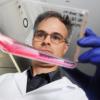
Removing Senescent Cells Halts Many Signs of Aging
#91
Posted 05 January 2012 - 10:42 PM
More to the point of the current study of eliminating senescent cells extending healthspan in this progeric mouse model, part of my transformed life is that I am finishing a PhD in the lab of Judith Campisi, an expert in cellular senescence, trying to identify compounds that are able to mitigate the pro-inflammatory secretions associated with senescent cells through the induction of apoptosis or through attenuating the production of pro-inflammatory molecules themselves. We are finding out interesting things about the phenomenon of senescence in the process.
I am proud to say that this work is funded by an organization I helped found, SENS Foundation, which I'm sure many are familiar with. Senescent cells are one of the major targets of the SENS platform. Up until this paper there was only supposition that senescent cells were guilty-by-association with degenerative disease. When I chose this strand to work on for my PhD, I wasn't even sure that it was going to be relevant so you can imagine how pleased I am that the direction I have chosen is one that offers some real potential for enhancing health and preventing age-related disease. It just proves yet again that Aubrey de Grey put his finger fairly pointedly on one of the culprits that is involved in the aging process. I've skimmed through some of the posts and it seems that there is some depth of understanding of the science, quite advanced which I'm not surprised to see. If there are questions or comments, I'm happy to have them. Great to see "Longecity" vibrant and active on these topics..
#92
Posted 06 January 2012 - 05:48 AM
Maybe you could comment on any of these:
- Could you give us an overview of your progress on the SASP based removal of senescent cells?
- How do you estimate its effectiveness over an immunity (NKG2D) approach?
- Since heterochronic parabiosis came up here as a potential useful empirical indicator of stem cell
and rejuvenation factor benefits, i couldn't find any data on lifespan extension of the older partners,
save that their improvements quickly reverted to their old state upon separation.
- What's the relative importance of pro-aging vs. rejuvenating factors?
#93
Posted 11 January 2012 - 04:58 PM
Thanks kevin! Great opportunity.
Maybe you could comment on any of these:
- Could you give us an overview of your progress on the SASP based removal of senescent cells?
- How do you estimate its effectiveness over an immunity (NKG2D) approach?
- Since heterochronic parabiosis came up here as a potential useful empirical indicator of stem cell
;and rejuvenation factor benefits, i couldn't find any data on lifespan extension of the older partners,
save that their improvements quickly reverted to their old state upon separation.
- What's the relative importance of pro-aging vs. rejuvenating factors?
Sure...
1) We are currently screening substances and have found a number which lower the secretion of pro-inflammatory molecules associated with senescence but have not found any that selectively kill them. We have many thousands of compounds yet to screen.
2) Enhancing the clearance of senescent cells by the immune system faces similar challenges to that of cancer. As senescent cells are non-dividing removing as many as possible via immune clearance would hopefully be a good strategy for lessening their impact on the microenvironment. I believe we will find methods of lowering senescence associated inflammation before we find ways of selectively inducing apoptosis and well in advance of genetic therapies to enhance immune clearance, but things are moving pretty quickly on many fronts so predictions are only that.
3) Parabiosis - There are no lifespan studies on parabiotic animals due to financial considerations although it would be an obvious experiment to follow the partners for effects. (as an aside, I wonder if a fetus could be considered a parabiotic partner for an old animal?... mothers tend to have extended benefits from pregancy. Would one be able to take 'young tissue' and grow it within an older animal to create a constant state of parabiosis?) That tissue function reverts rather quickly after removal of the rejuvenative influence of young serum clearly tells us that it isn't going to be a simple fix. At the moment, we truly don't know how the aged-environment influences stem cell function very well and it is likely niche architecture which needs to be restored. Stem cell function in drosophila testes have a "hub and spoke" architecture producing a polarity within the niche. Over time, the architecture and polarity of the niche deteriorates due to changes in ECM and adhesion molecule expression causing a disorientation of the mitotic spindle and G1 arrest in dividing progenitor cells. If this pattern plays out into other niches in other tissues, reconstruction of the stem cell niche ECM and expression of adhesion molecules may be an important part of restoring progenitor pool function and tissue homeostasis.
4) From the above I think you might gather that I believe pro-aging factors are just as important at rejuvenating factors. Stem cell function and its role in tissue homeostasis is what is compromised with age.
Edited by kevin, 11 January 2012 - 04:58 PM.
#94
Posted 11 January 2012 - 08:09 PM
The idea of a fetus as a beneficial parabiotic partner is very interesting, not least given the fact that the embryo apparently doesn't suffer the ill effects observed in the animal studies.
Also - probably unlikely but maybe worth mentioning - until any longterm animal studies are done, i wonder if it's possible to discern and quantify maternal lifespan benefits in relation to total pregnancy time.
This is all very exciting and i think i'm not alone in hoping you find the time to drop by from time to time and keep us updated.
#95
Posted 11 January 2012 - 08:49 PM
1) We are currently screening substances and have found a number which lower the secretion of pro-inflammatory molecules associated with senescence but have not found any that selectively kill them. We have many thousands of compounds yet to screen.
Kevin, thanks for checking in here! This is an exciting result in and of itself. Do any of the hits in your assay have the necessary blend of potency and bioavailability to be useful in vivo? Are you able to divine any Structure Activity Relationships from the hits to date? As you suggest above, it does seem like attacking SASP will be easier than eliminating senescent cells, at least in the near term, and a decent suppression of SASP ought to accomplish a similar result at any rate.
#96
Posted 11 January 2012 - 10:35 PM
#97
Posted 12 January 2012 - 04:27 AM
I read some time ago about artificial antibodies and after reading Kevin's posts, I now wonder if it would be possible to create antibodies to the substances secreted by senescent cells and ultimately the senescent cells themselves. Would somebody with antibody knowledge please comment.
It wouldn't help to create an antibody to any of the secreted substances because they just float away from the senescent cell. You have to find a molecule that's expressed on the surface of the cell, and it needs to be specific to senescent cells. If the molecule is also expressed on healthy cells, and you use it to generate some sort of cell-killing signal, you'll be killing healthy cells, which you don't want.
An antibody approach to killing senescent cells has some advantages over antibody approaches to killing cancer cells. The senescent cell is not dividing, so there's no need to hurry in killing it. It doesn't represent a lethal threat down to the level of (theoretically) a single cell, so it's ok if you miss a few. It would even be ok to kill a few healthy cells, as long as you didn't kill too many, and you simultaneously managed to kill "enough" senescent cells.
#98
Posted 12 January 2012 - 06:58 AM
#99
Posted 24 January 2012 - 09:10 AM
If you are trying to think of ways to kill senescent cells, think cancer treatment:
If you can get senescent cells to recruit a certain kind of molecule you can selectively kill them.
---- There was the folic-acid gold array (which worked since cancer recruits folic acid, and they made a gold array attached to folic acid, they would then hit the gold array with a specific wave length of light to heat and destroy the cell)
---- Chemotherapy where the poison is selectively recruited to cancerous cells.
I'm not sure what kind of molecules senescent cells would recruit though...
It might be better you can get senescent cells to NOT recruit a certain kind of molecule. Here the recruited molecule needs to be 'antidote' to the second therapy which kills cells without the antidote. This might be easier since there are probably quite a few molecules senescent cells dont need, but I don't know what they are :/
I'm just brainstorming here trying to think what these cells might recruit or not recruit:
- Senescent cells have more and larger lysosomes (1)
- β-galactosidase is much more active in senescent cells. This protien catalizes the hydrolysis of β-galactosides (like lactose). It would be interesting if a lactose like molecule might leave some residue in the senescent cells, which could then be targeted.
- If senescent cells have p53 turned on, perhaps activating the other pro-apoptotic signals would give sensecent cells the push they need to enter into apoptosis. (Caspase 8 & 9)
Edited by lucid, 24 January 2012 - 09:10 AM.
#100
Posted 24 January 2012 - 12:20 PM
I wonder if cell surface bound IL-1α could be a target? Perhaps a non-neutralizing IL-1α antibody could be used to tag senescent cells for elimination. Possibly even develop an antibody that "defangs" senescent cells by interupting the cytokine signaling.
http://freepdfhostin.../d77cd2cd37.pdf
http://jcb.rupress.o...47.figures-only
Some senescent cells express, among other cytokines, TNF. Many patients with autoimmune conditions are already on TNF blocking antibody drugs. Some of these, like Humira, lyse cells expressing TNF and could therefore potentially remove some senenscent cells.
IN fact, TNF blocking antibody drugs have been found to dramatically reduce the risk of aging-related dementia in patients taking these drugs for RA, AS, etc. Could this be related?
Edited by viveutvivas, 24 January 2012 - 12:24 PM.
#101
Posted 28 January 2012 - 10:48 AM
Edited by AgeVivo, 28 January 2012 - 10:48 AM.
#102
Posted 28 January 2012 - 01:04 PM
#103
Posted 24 February 2012 - 10:46 AM
I have a strategy on how we could get rid of senescent cells (SC): poison them (and only them).
First, we should study the difference in the metabolism between normal and SC. Focus on what a normal cell CAN do that a SC CAN'T?
I think since SC have a slower metabolism and reduced funcionality they should have less capacity to handle aggressive envrionment than normal cells. After all, they are just cellular "grandpas" ;-)
So, an agressive chemical that normally healty cells can handle pretty well can become a perfect SC killer. Or maybe they can't handle high temperature, or low grade radioterapy...
#104
Posted 24 February 2012 - 07:12 PM
Not saying it can't work, but anti TNF alpha are *full* of side effects though
Well, they are immunosuppressive, but how bad could it be give that Humira is a $13B per year drug? Maybe it's just that the advantages outweigh the disadvantages, assuming you have RA or some other horrible inflammatory condition. The one thing that I wonder is given the large number of people taking Humira, is it possible to see an anti-aging effect, separate from the recovery from severe inflammation? Maybe part of the reason people like it so much is it's actually killing senescent cells...
#105
Posted 10 March 2012 - 03:21 AM
Here, on the basis of an investigation of several molecular and morphological markers of apoptosis and autophagy, we propose that the main cell death mechanism occurring in senescent keratinocytes is not apoptosis but autophagic cell death. This conclusion would appear to apply to other cell types as well, since we observed increasing vacuole formation in several other senescent epithelial cell types (mammary and prostatic epithelial cells, data not shown) and in dermal fibroblasts (and prostatic fibroblasts, data not shown).
...we show that when the initial phases of autophagy are blocked with 3-methyladenine, the death of senescent cells is delayed. Moreover, if the acidification required for the final degradation of cell components is blocked, autophagic vacuoles full of debris accumulate inside corpses.
The last argument concerns Beclin-1 expression. This might be a key determinant of the switch from autophagy as a vital process of cell component turnover to autophagy as a lethal process. Unlike autophagy induced by serum or amino acid deprivation that involves beclin-1 but without any increase in expression, autophagic programmed cell death induced by etoposide appears to be associated with an increase in Beclin-1 expression. We show here that Beclin-1 expression is induced at the presenescence stage, supporting the notion that autophagic cell death could follow.
Our videomicroscopic recordings also show that dying senescent cells do evacuate some dense material, probably corresponding to the non-degradable content of their autophagolysosomes. This suggests that the autophagic process is functional in senescent cells until late. Moreover, our electron micrographs show that the autophagic vacuoles accumulating in senescent cells are functional, since most of them contain only small pieces of degraded material. In contrast, when the degradation process is blocked with bafilomycin, these vesicles retain more material.
Senescent Cells Do Not Die by Apoptosis
Our conclusion is entirely consistent with the apoptosis-resistance of senescent cells, an unpopular fact that is nevertheless clearly established for several cell types and several apoptosis inducers.50,51,52,53 Other groups have examined whether senescent cells die by apoptosis, and conflicting results have been published. In one study, senescent fibroblasts appeared caspase-3 positive, with only 2% of them showing other typical apoptotic changes. ... A study focusing on keratinocytes concluded, in accordance with our results, that apoptotic cells are a minority subpopulation and that their number does not change with passaging.
...The sole established universal marker of senescence, SA-β-Gal activity, increases in the course of normal human and mouse aging...
My personal take on this is that autophagy is impeded in senescent cells by metabolites of subclinical, slowly accumulating with age, intracellular pathogens. Healthy cells dispose of such infections via xenophagy, a kind of autophagy selective for degradation of intracellular bacteria and viruses . The survival strategy of these pathogens is to impede the process autophagy at one of its many stages. Usually it is blocked at the point where an autophagosome must mature or further down when it fuses with a lysosome. As the result, autophagosomes containing infective material accumulate, crowding the cytoplasm.
Nothing upregulates autophagy as well as nutrient deprivation, aka fasting. Then an infected cell is able to overcome the inhibitory signals of the invaders, following which it gets rid of them and renews itself in the process. Or it dies.
Edited by xEva, 10 March 2012 - 03:22 AM.
#106
Posted 24 May 2012 - 01:43 AM
"Salvestrols are natural compounds in the diet which are
converted inside diseased cells, by a specific enzyme,
into compounds that can destroy the diseased cell ..."
"... This enzyme is present only in malfunctioning cells and when it encounters a salvestrol it converts it into a form which is toxic to the sick cell. Because the enzyme is not present in healthy cells the Salvestrols exert no ill effects on them ..."
"... They are part of a natural rescue mechanism and
may be essential to maintain good health."
http://www.salvestrol.ca/index.asp
A pubmed search for Salvestrols gives no result.
Searching for info on Gerry Potter (Professor of Medicinal Chemistry) and Dan Burke (Emeritus Professor of Pharmaceutical Metabolism and former head of the School of Pharmacy) gives these:
http://www.practitio...scientists.html
http://news.bbc.co.u...lth/1841709.stm
Reading through the site; my gut feeling is that this is legit.
"The inhibition from some inhibitors will last the full life cycle of the enzyme. It is important to reduce or eliminate exposure to inhibitors to give Salvestrols their best chance of being activated. Strong inhibitors of CYP1B1 include carbon monoxide (e.g. in tobacco smoke), vitamin B17 (also known as amygdalin or laetrile), resveratrol, and certain agrochemical fungicides"
#107
Posted 03 August 2012 - 12:55 PM
http://www.medicalne...ases/248551.php
So; I'm now looking for a supplement that upregulates the expression of the ASPP2 gene.
#108
Posted 03 August 2012 - 01:07 PM
http://atlasgenetics...2667ch1q42.html
It seems so?
That means take resveratrol?
Edited by Logic, 03 August 2012 - 01:09 PM.
#109
Posted 03 August 2012 - 01:19 PM
It seems to rescue cells by inducing protein autophagy.
We showed previously that lithium is protective in HD cell models, because it reduced mutant huntingtin aggregates and cell death...
So wouldn't the ideal be a treatment that induced autopahgy at the protein level followed by a treatment that induced it at the cellular level?
#110
Posted 03 August 2012 - 01:35 PM
So Trehalose, Lithium, Resveratrol? Salvestrols??
Any ideas on dosage Turnbuckle?
#111
Posted 03 August 2012 - 08:58 PM
#112
Posted 04 August 2012 - 01:41 PM
Is ASPP2 P53?
http://atlasgenetics...2667ch1q42.html
It seems so?
That means take resveratrol?
ASPP2 is a P53 binding protein, that is, a protein that binds P53. It's not P53 itself. Resveratrol does have something to do with apoptosis; if you take very high doses, it encourages apoptosis, and if you take low doses, it's said to be anti-apoptotic. P53 is also involved in apoptosis.
That is an awesome link, BTW. Thanks for that.
#113
Posted 04 August 2012 - 03:48 PM
ASPP2 is a P53 binding protein, that is, a protein that binds P53. It's not P53 itself. Resveratrol does have something to do with apoptosis; if you take very high doses, it encourages apoptosis, and if you take low doses, it's said to be anti-apoptotic. P53 is also involved in apoptosis.
That is an awesome link, BTW. Thanks for that.
Ah. Thx again Niner.
Am I correct in thinking 500+ mg is the dosage where people saw apopsosis of senecent cells?
Edited by Logic, 04 August 2012 - 03:49 PM.
#114
Posted 04 August 2012 - 05:59 PM
Hi to everybody,
I have a strategy on how we could get rid of senescent cells (SC): poison them (and only them).
First, we should study the difference in the metabolism between normal and SC. Focus on what a normal cell CAN do that a SC CAN'T?
I think since SC have a slower metabolism and reduced funcionality they should have less capacity to handle aggressive envrionment than normal cells. After all, they are just cellular "grandpas" ;-)
So, an agressive chemical that normally healty cells can handle pretty well can become a perfect SC killer. Or maybe they can't handle high temperature, or low grade radioterapy...
Polar bear club?
#115
Posted 04 August 2012 - 08:14 PM
Let's say you could kill off senesent cells either by the immune system or chemo. Wouldn't such a large number of dying or dead cells cause significant problems for the elderly by itself ? After all you don't want a successful treatment and dead patient.
Shouldn't be a problem if they are removed gradually and efficiently so that the apoptosis doesn't spread to healthy cells - senescent cells cannot reproduce and work sub-efficiently so their loss shouldn't impair the functioning of the organs and tissues, but if they are removed fast in certain connective tissues it could cause a problem.I would bet my hard-earned $ that dry fasting clears senescent cells.
Fasting doesn't cure arthritis and rheumatism. You just lost your hard earned $.
Don't think there was any belief of a cure of any kind. Don't underestimate the healing powers of fasting, intermittent fastiing, and intermittent protein restriction.
#116
Posted 05 August 2012 - 02:20 AM
Am I correct in thinking 500+ mg is the dosage where people saw apopsosis of senecent cells?
500+ of resveratrol? The pro-apoptotic dose is probably multiple grams in a human, fairly huge doses, I think. However, I don't know of any evidence that it works for senescent cells specifically. If a senescent cell were sufficiently damaged that it were on the verge of apoptosis, maybe resveratrol would do it, but I'm not sure they are typically in such a state. People have taken large resveratrol doses, and no one has suddenly turned young that I know of.
#117
Posted 05 August 2012 - 10:51 AM
I read somewhere here about people seeing damaged cells die while taking Resv, but couldnt remember what dosages they were taking.
I'm still looking for a supplement that upregulates the ASPP2 protein, but am out of my depth here.
Any ideas people?
Anthony?
http://atlasgenetics...2667ch1q42.html
Edited by Logic, 05 August 2012 - 10:53 AM.
#118
Posted 05 August 2012 - 11:34 AM
Just to be a total buzzkill here: you should most times assume that in the absence of specific in vivo human research using combinations of supplements, that the combination is as likely to extend your life as to kill you quicker.
#119
Posted 05 August 2012 - 06:08 PM
http://www.jci.org/articles/view/37948
Autophagy just became fun!
#120
Posted 05 August 2012 - 09:38 PM
Curcumin induces autophagy to protect vascular endothelial cell survival from oxidative stress damage
http://www.landesbio...ache=1071058157
This paper confuses me as HSV depletes L-arginine
http://www.landesbio..._full_text=true
Too much autophagy?
Also tagged with one or more of these keywords: cellular, hacking, senescence, age, immortality, proof, senescent cells, senescent cells
14 user(s) are reading this topic
0 members, 14 guests, 0 anonymous users




















































